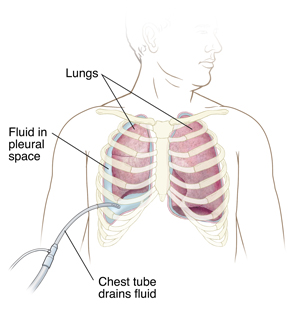Thoracentesis is a procedure that removes extra fluid from the pleural space. This space is between the outside surface of the lungs (pleura) and the chest wall. The extra fluid is called pleural effusion. Thoracentesis may be done to take a sample of the fluid. It can then be tested to help find the cause. Or the procedure may be done to drain the extra fluid if you are having trouble breathing.
Home care
-
You may have some pain after the procedure. Your provider may prescribe pain medicine, if needed. Take these exactly as directed.
-
If you stopped taking other medicines before the procedure, ask your provider when you can start them again.
-
Take it easy for 48 hours after the procedure. Don't do anything active until your provider says it’s OK.
-
Don't do strenuous activities, such as lifting, until your provider says it’s OK.
-
You will have a small bandage over the puncture site. You may remove the bandage in 24 hours, or when your provider says it's OK.
-
Check the puncture site for the signs of infection listed below.
Follow-up
Make a follow-up appointment with your provider as directed. During your follow-up visit, your provider will check your healing. Be sure to let your provider know how you are feeling.
When to call your healthcare provider
Call your provider right away if you have any of these:
-
Fever of 100.4°F (38°C) or higher, or as directed
-
Pain that doesn't get better after taking pain medicine
-
Signs of infection at the puncture site. These include increased pain, redness, warmth, swelling, or fluid leaking that is green or yellow or smells bad.
-
Fluid draining from the puncture site
-
Bleeding from the puncture site
When to call 911
Call 911 or get care at the nearest emergency department if any of these occur:
-
Chest pain that is unusual or suddenly gets worse
-
Shortness of breath
-
Coughing up blood


